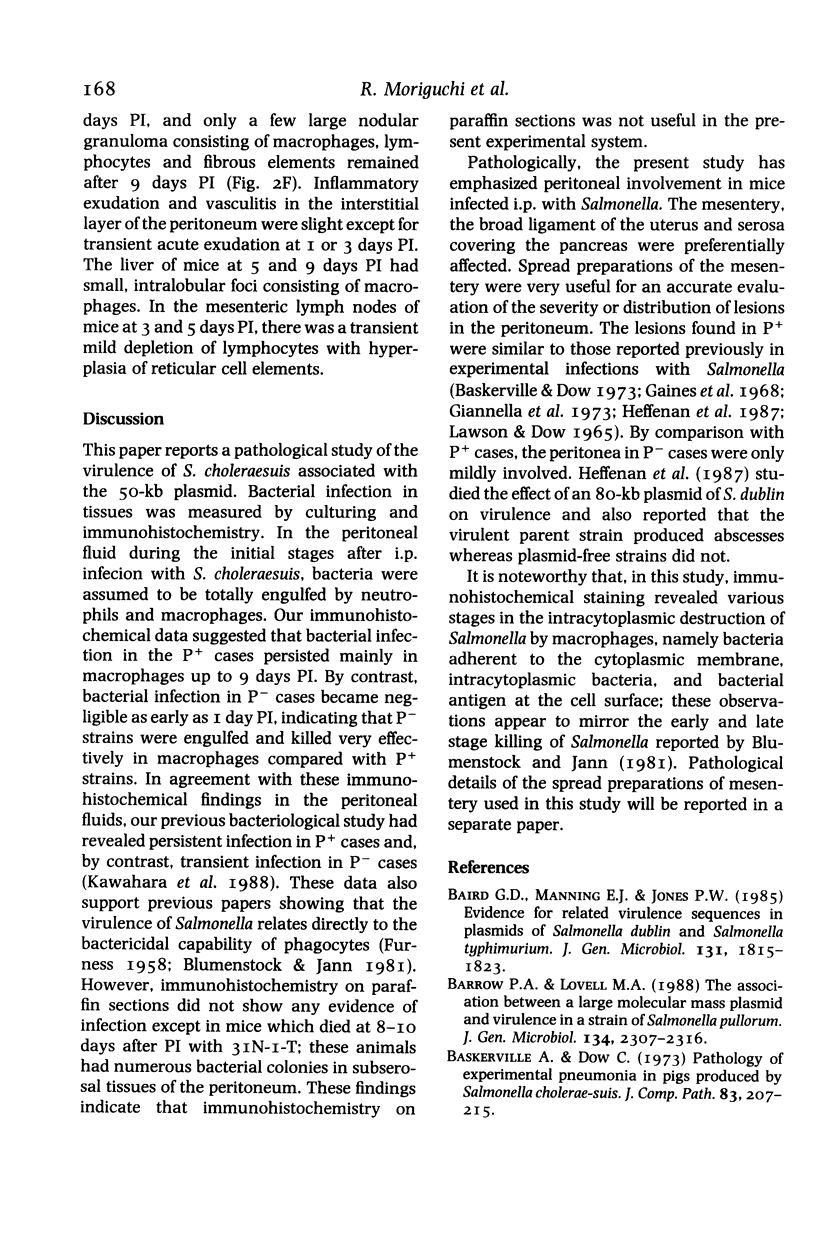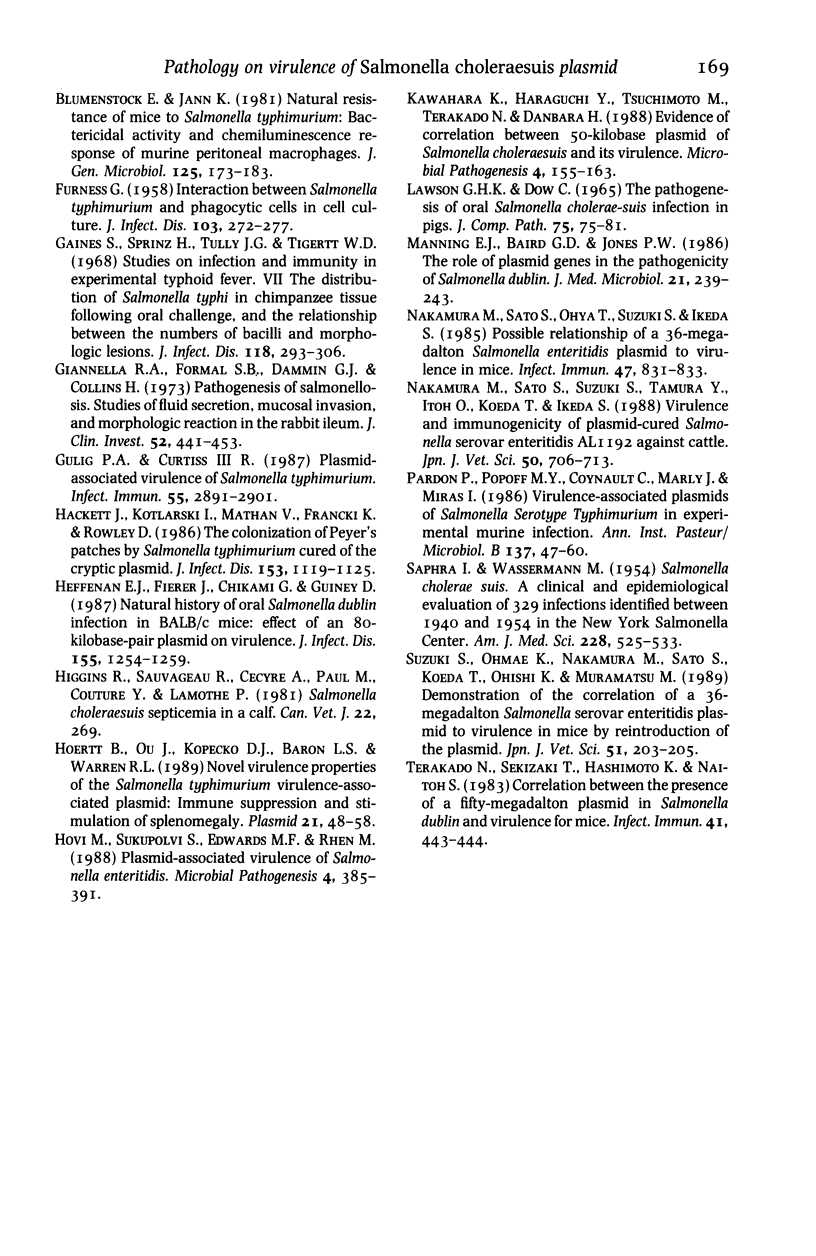Abstract
The virulence of Salmonella choleraesuis associated with 50-kilobase plasmid was assessed by the pathology produced in mice. The strains used in this study were plasmid-contained RF-1, plasmid-cured 31N-1 and plasmid-reintroduced 31N-1-T. Mice were intraperitoneally inoculated with sublethal doses of these bacteria and chronologically necropsied. Pathologically, the plasmid-positive (P+) cases were distinctly different from the plasmid-negative (P-) ones, especially in the peritoneal fluids and peritoneum. The P+ cases were characterized by extensive, granulomatous peritoneal lesions composed of abundant macrophages frequently with neutrophils, sero-fibrinous exudates and vasculitis and the bacterial antigens were detected in such sites. By contrast, the peritonea in the P- cases were mildly involved and had scattered granulomas. The bacterial antigens were hardly visible in all tissues examined. It is suggested that spread preparations of the mesentery may be a useful tool for observing the distribution of peritoneal lesions.
Full text
PDF






Images in this article
Selected References
These references are in PubMed. This may not be the complete list of references from this article.
- Barrow P. A., Lovell M. A. The association between a large molecular mass plasmid and virulence in a strain of Salmonella pullorum. J Gen Microbiol. 1988 Aug;134(8):2307–2316. doi: 10.1099/00221287-134-8-2307. [DOI] [PubMed] [Google Scholar]
- Cécyre A., Paul M., Couture Y., Lamothe P. Salmonella choleraesuis septicemia in calf. Can Vet J. 1981 Aug;22(8):269–269. [PMC free article] [PubMed] [Google Scholar]
- FURNESS G. Interaction between Salmonella typhimurium and phagocytic cells in cell culture. J Infect Dis. 1958 Nov-Dec;103(3):272–277. doi: 10.1093/infdis/103.3.272. [DOI] [PubMed] [Google Scholar]
- Giannella R. A., Formal S. B., Dammin G. J., Collins H. Pathogenesis of salmonellosis. Studies of fluid secretion, mucosal invasion, and morphologic reaction in the rabbit ileum. J Clin Invest. 1973 Feb;52(2):441–453. doi: 10.1172/JCI107201. [DOI] [PMC free article] [PubMed] [Google Scholar]
- Gulig P. A., Curtiss R., 3rd Plasmid-associated virulence of Salmonella typhimurium. Infect Immun. 1987 Dec;55(12):2891–2901. doi: 10.1128/iai.55.12.2891-2901.1987. [DOI] [PMC free article] [PubMed] [Google Scholar]
- Hovi M., Sukupolvi S., Edwards M. F., Rhen M. Plasmid-associated virulence of Salmonella enteritidis. Microb Pathog. 1988 May;4(5):385–391. doi: 10.1016/0882-4010(88)90066-6. [DOI] [PubMed] [Google Scholar]
- Manning E. J., Baird G. D., Jones P. W. The role of plasmid genes in the pathogenicity of Salmonella dublin. J Med Microbiol. 1986 May;21(3):239–243. doi: 10.1099/00222615-21-3-239. [DOI] [PubMed] [Google Scholar]
- Nakamura M., Sato S., Ohya T., Suzuki S., Ikeda S. Possible relationship of a 36-megadalton Salmonella enteritidis plasmid to virulence in mice. Infect Immun. 1985 Mar;47(3):831–833. doi: 10.1128/iai.47.3.831-833.1985. [DOI] [PMC free article] [PubMed] [Google Scholar]
- Nakamura M., Sato S., Suzuki S., Tamura Y., Itoh O., Koeda T., Ikeda S. Virulence and immunogenicity of plasmid-cured Salmonella serovar enteritidis AL1192 against cattle. Nihon Juigaku Zasshi. 1988 Jun;50(3):706–713. doi: 10.1292/jvms1939.50.706. [DOI] [PubMed] [Google Scholar]
- SAPHRA I., WASSERMANN M. Salmonella cholerae suis: a clinical and epidemiological evaluation of 329 infections identified between 1940 and 1954 in the New York Salmonella Center. Am J Med Sci. 1954 Nov;228(5):525–533. doi: 10.1097/00000441-195411000-00005. [DOI] [PubMed] [Google Scholar]
- Suzuki S., Ohmae K., Nakamura M., Sato S., Koeda T., Ohishi K., Muramatsu M. Demonstration of the correlation of a 36-megadalton Salmonella serovar enteritidis plasmid to virulence in mice by reintroduction of the plasmid. Nihon Juigaku Zasshi. 1989 Feb;51(1):203–205. doi: 10.1292/jvms1939.51.203. [DOI] [PubMed] [Google Scholar]
- Terakado N., Sekizaki T., Hashimoto K., Naitoh S. Correlation between the presence of a fifty-megadalton plasmid in Salmonella dublin and virulence for mice. Infect Immun. 1983 Jul;41(1):443–444. doi: 10.1128/iai.41.1.443-444.1983. [DOI] [PMC free article] [PubMed] [Google Scholar]






